If OJ had this Bronco, he might have gotten away with it.
Well, of course, he did get away with it. But never mind that. The new Bronco is made to order for getting to anywhere a four-wheeled vehicle can go.
And getting back from there, too.
What It Is
The Bronco is a two or four-door mid-sized SUV and unlike any other new SUV – with the sole exception of the Jeep Wrangler, which it’s meant to compete with. Both of them are capable of going places off-road that very few others dare, especially when equipped with their available beadlock-capable tires, three locking differentials and enough ground clearance to drive over some other SUVs. 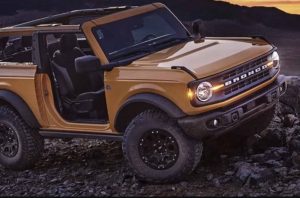
They each also feature removable doors and tops and – it’s a miracle! – come standard with manual transmissions. This alone sets them apart from every other new SUV available since all of the others are automatic-only.
The Ford starts at $29,300 for the base two-door trim – almost the same asking price as the base Wrangler two-door, which lists for $29,995.
It comes standard with a turbocharged 2.3 liter four cylinder engine (borrowed from the Mustang) paired up with a seven speed manual transmission and a part-time/selectable four-wheel-drive system. A ten speed automatic is optional.
Adding another pair of doors bumps the asking price to $33,450 – and the total cargo capacity to 73 cubic feet from 52.3 cubic feet. Four door versions of the Bronco also come standard with the ten speed automatic transmission.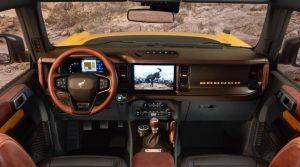
From there, you can select from among six additional trims, including a new high-performance Raptor iteration (four doors only) that comes with 37 inch all-terrain tires, Fox heavy-duty 3.1 inch diameter shocks with internal and external fluid reservoirs, modified control arms, nearly 12 inches of ground clearance, 13-14 inches of wheel articulation (60-70 percent more than the standard Bronco) and – uniquely – a twin turbocharged 3.0 liter V6 that summons 400 horsepower.
This one stickers for $68,500 and specifically targets the comparably capable (and even more powerful) V8-powered Jeep Wrangler Rubicon 392, which lists for $77,095.
In addition to the Raptor, Ford has also added an Everglades variant to the roster.
This one includes the extras that come with the Sasquatch off-road package (suspension lift, beadlock-capable 17 inch wheels with 35 inch Goodyear A/T tires and a more aggressive final drive ratio for more leverage at low speeds, plus locking front and rear axles) and adds an air snorkel for the engine, the ability to ford 36.4 inches of water, a winch, heavier-duty front fender, different fender flares and unique graphics.
Also, the Sasquatch package mentioned above – which can be added to most Broncos – is now also available with the manual transmission (in two door models).
What’s Good
Wide price range makes this real-deal off-roader accessible.
Multiple bodystyles and configurations.
Much more civilized than it looks – notwithstanding how capable it is.
What’s Not So Good
You may be able to afford the Bronco – but will you be able to afford the gas?
Manual transmission only available with the 2.3 liter engine.
A more teched-out machine than the Wrangler, which relies on simpler – and possibly more long-term hardy – V6 and V8 engines without turbos.
The original Bronco – the one this new Bronco is meant to emulate – was powered by nothing less than a six cylinder engine and often with a V8 engine which was optional back in 1966. That’s no longer necessary today, because four cylinder engines make more power now than V8s did, back then.
The new Bronco’s standard 2.3 liter four cylinder engine, for instance. It is about half the size of the available 5.0 liter (289 cubic inch) V8 that was on offer in the original Bronco of the mid-late ’60s and ’70s, but makes 300 horsepower – 100 more than the original Bronco’s optional V8 and almost 200 more horses than the original Bronco’s 105 horsepower six. 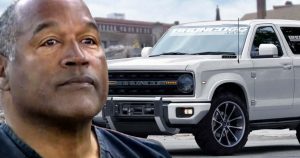
Even the OJ-era Bronco’s larger 5.8 liter (351 cubic inch) “high output” V8 only mustered . . . 210 horsepower back in the early ’90s. No wonder OJ couldn’t get away.
Well, today we’re getting 300 horses out of 2.3 liters and a not-horrific 20 city, 21 highway, too. This is about 5 MPG better than the V8 Bronco OJ drove could manage.
It’s also stronger than the Jeep Wrangler’s standard 3.6 liter V6, which musters a less impressive 265 horsepower.
The reason, why, of course, is the turbocharger that boosts the Ford’s four – increasing its effective displacement when more-than-four power is needed, by forcing more air into the engine’s cylinders, increasing their capacity – which makes each explosion within those cylinders more forceful. If today’s V8s were turbocharged, they’d be making more power than V12s used to make. 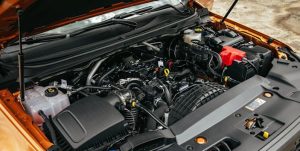
You can pair the Bronco’s 2.3 liter engine with either a seven speed manual or (optionally) a ten speed automatic transmission. With the manual, first gear is a “crawler” – what used to be called a granny gear – meant to increase mechanical leverage when that’s wanted. It’s a really deep 6.588:1 ratio (first gear in the ten speed is 4.714:1).
The manual’s second gear is everyday first gear, with a 4.283:1 ratio.
With either box you end up on top with an MPG-friendly final drive ratio – 0.646:1 with the manual, 0.636:1 with the ten speed – both meant to cut the revs at highway speeds, allowing this Bronco to get better mileage at 75 (with much less drivetrain noise) than the original Bronco did at 45.
The manual is, however, only available with the 2.3 liter engine.
A 2.7 liter V6 with two turbos is the next-up engine offering. This one doesn’t make that much more horsepower (330) than the 2.3 liter four with just one turbo – but it does make a lot more torque (415 ft.-lbs. at 3.100 RPM vs. 325 ft.-lbs. at 3,400 RPM) which makes it even better-suited for the kind of low-speed grunt work the Bronco is built for.
Gas mileage goes down a little – to 17 city/17 highway with this one – which is paired only with the ten speed automatic. 
All versions of the Bronco are equipped with four-wheel-drive, with a two-speed transfer case and Low range gearing. Some models get a center locking differential in addition to the front and rear locking diffs. There are also multiple driver selectable GORT modes (that can be engaged via a rotary knob on the center console. Each one tailors throttle tip-in and (automatic models) shift points for snow/sand/mud and other such driving situations.
The Bronco Raptor gets the largest of the small engines that power the new Bronco. Just 3.0 liters – but 400 horsepower and 430 ft.-lbs. of torque. It’s not quite as potent as the 470 horsepower 6.4 liter V8 that powers the Wrangler Rubicon 392 – but it’s much more affordable. The price difference between the Bronco Raptor and the Rubicon 392 Wrangler is $8,595 – which buys a lot of gas, even at $4 per gallon.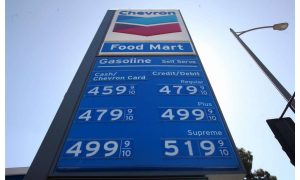
Speaking of which.
EPA gas mileage numbers for the Raptor hadn’t been posted when this review was written in early April but will likely be not too far off those posted by the twice-turbo’d 2.7 liter V6. This being a function of the smallness of the Raptor’s engine, which is only marginally larger than the 2.7 engine (which isn’t much larger than the 2.3 liter four cylinder engine). The whole idea is to reduce the appetite – and the “emissions” (in air quotes because we’re talking about carbon dioxide, chiefly, and it’s only an “emission” in the sense that it is emitted, not that it is dangerous – like the way your breath fogs a mirror) of the engine as per government testing regimes.
It works, too – on the tests. If you run with a light foot, the engine stays small – and so does its appetite (and “emissions”), relatively speaking. Of course, when your foot gets heavier. . . but never mind that.
The Ford’s vs. the Jeep’s top engines presents a study in contrasting approaches. Horsepower via displacement – the Jeep’s V8 – and turbos as the replacement for displacement.
Sadly, this will shortly also be literally the case as regards the Jeep’s 392 Hemi V8 – which is soon to be history, replaced by . . . a 3.0 liter six, boosted to V8 power via turbos. This is the future of powerful engines, which wouldn’t be possible without using turbochargers to make small engines powerful. Big engines like the Wangler’s 392 6.4 liter Hemi V8 being impossible in a regulatory environment that insists on ever-higher gas mileage and ever lower “emissions” of carbon dioxide.
Tires are critical.
Not just for off-roading or not getting stuck in snow, on road. Also for the ride, everywhere. The Bronco I test drove had the Sasquatch package, which means it had a bevy of off-road upgrades. Usually – typically – a vehicle all jacked up and ready to rock crawl will feel like a rock . . . on the road.
But for the tires.
The tall sidewall, puffy-balloon-type Goodyear 35-inchers than come with this thing. They are meant to flex and give, as they feel their way over terrain. This has the happy side-effect of softening up the on-road ride remarkably – such that even a Sasquatch feels almost house-broken.
Drive the thing and see. Then go for a drive in an old Bronco from the ’60s. Or the ’90s. Or – for that matter – a new “luxury-sport” sedan from the now, shod with inch-high sidewall tires that can’t flex or give and for that reason convey the feel of every pothole and bump in the road, straight to your backside. It is hilariously ironic that a no-holds-barred off-road machine such as this is more comfortable to drive on road than many cars that dare not leave the driveway if there’s any snow on the ground.
But does it handle like an ocean liner on skates in the curves? Surely, it must at least be a bit tipsy? But – au contraire – it isn’t. Once again – remarkably – the thing corners more competently than most people are capable of driving their “luxury-sport” sedans. Its limits are almost as high as its ground clearance – again, a remarkable thing. Ford has done astounding work here. Especially relative to the Jeep Wrangler which – though very capable and also very cool, being as contrarian as it is in these Latter Days – is an older design and feels it.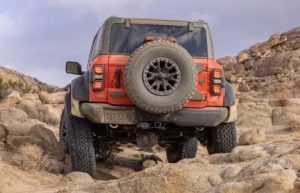
There is less wind (and tire) noise intrusion in the Ford, which also feels tighter in terms of its structure and more insulated from the world outside. The Jeep is a more elemental-feeling vehicle, not there’s anything wrong with that. But the differences are noticeable and that’s good because it gives you a real choice to make between these two.
Another difference is power.
More precisely, power delivery. The Ford’s four cylinder engine feels stronger than the Jeep’s V6 – because it is. A thirty-five horsepower advantage is not a small difference. Also because it makes a lot more torque, a lot sooner – 325 ft.-lbs. at 3,400 RPM vs. the Jeep V6’s 260 ft.-lbs. at 4,800 RPM.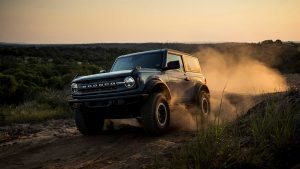
The Jeep fires back with its optional diesel six, a type of engine the Ford doesn’t offer. It’s another study in contrasts – in that it surpasses the torque output of the Ford’s optional 2.7 liter (gas) V6, belting out 442 ft.-lbs. vs. 415 for the Ford. And it’s capable of almost 30 MPG on the highway. But it only makes 260 horsepower and is strictly a low-RPM, low-end-grunt engine. This is great for off-road, of course. And for towing.
But it does not feel as strong once you’re rolling, on road.
Once again it’s nice that there are such differences – and choices. The pity is they’ve become much less common.
The new Bronco is meant to emulate the look of the original one – not the OJ one. It has many reminiscent styling similarities, including the retro-sealed-beam-looking round headlights (which are actually modern LED lights) and 90 degree angles. Plus, of course, the removable roof, which can be taken off in sections or entirely. Soft and hard shells are available.
But then you get in and it’s definitely 2022 – not 1972.
You sit in front of an LCD main gauge cluster which – like most – is configurable and so can display more than just what you see, as analog gauges do. To your right is a bigger LCD screen, through which you access the audio system the GPS maps and also some secondary info screens depicting which axles are engaged, your mileage/range and so on.
Yet functionally, it’s still much as it was – back in ’72. Most of the controls you need to use regularly – the temperature/fan controls for instance – are still physical rather than digital and can be operated by hand – and by feel. Especially happily so the radio controls, including for tuning.
Speaking of the radio . . .
God bless Ford for end-running the saaaaaaaaaaaaaaaaaaaaaafety geeks who – in every other case – have made it impossible to connect a phone/iPod to the car’s audio system while the thing is moving. Here – instead – a screen comes up that asks whether it’s the passenger who’s trying to connect his phone/iPod.
Click “yes” and you’re good to go!
Other fun features include available wash-out flooring with drain plugs built into the floors and factory accessory wiring/toggle switches you can use to power whatever accessories you decide to add.
One area where the new Bronco differs significantly from the original is the number of doors that are available. The first-generation Bronco had only two. So did OJ’s. This one has two – or four. This greatly expands the everyday viability of the new Bronco, which has ample room for both passengers and cargo – up to 73 cubic feet (and room enough to carry 2x4x8s home with the rear gate (sideways opening) closed.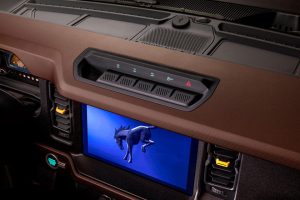
The two-door is more personal and practical for the single person – who is also probably on a tighter budget than the Family Guy who needs four doors. It also comes standard with inherently hardy features such as steel 16 inch wheels (with 30 inch tires) and – the big one – that manual transmission, which (like all manuals) remains defiantly mechanical. No electronic controls here. No chips to fritz. No sensors that might one day stop sensing. Just a clutch – much cheaper to replace than a transmission.
The Rest
The Bronco’s return was conceived when Orange Man Bad – and gas cost about $2 per gallon. This was about two years ago. Now Orange Man Gone – and gas costs twice-plus that. And so does everything else. Leaving less money to buy gas.
Filling up the two-door’s 16.9 gallon tank with regular (premium is wanted for maximum power) will set you back about $75 at current prices. At 17 MPG, this setting back will happen often. The four door – which has a larger 20.8 gallon tank – costs about $90 at current prices to refill.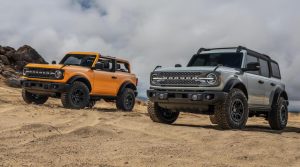
The monthly gas bill approaches the monthly payment.
Even so, the best things in life often aren’t free.
This one of them.
The Bottom Line
Whatever your situation – or wants – there’s probably a Bronco that suits.
Which is perhaps the thing that makes this rig so appealing, given how one-size-fits-all most of the rest are.
. . .
Got a question about cars, bikes or anything else? Click on the “ask Eric” link and send ’em in! Or email me at EPeters952@yahoo.com if the @!** “ask Eric” button doesn’t work!
If you like what you’ve found here please consider supporting EPautos.
We depend on you to keep the wheels turning!
Our donate button is here.
If you prefer not to use PayPal, our mailing address is:
EPautos
721 Hummingbird Lane SE
Copper Hill, VA 24079
PS: Get an EPautos magnet or sticker or coaster in return for a $20 or more one-time donation or a $10 or more monthly recurring donation. (Please be sure to tell us you want a magnet or sticker or coaster – and also, provide an address, so we know where to mail the thing!)
My eBook about car buying (new and used) is also available for your favorite price – free! Click here. If that fails, email me at EPeters952@yahoo.com and I will send you a copy directly!


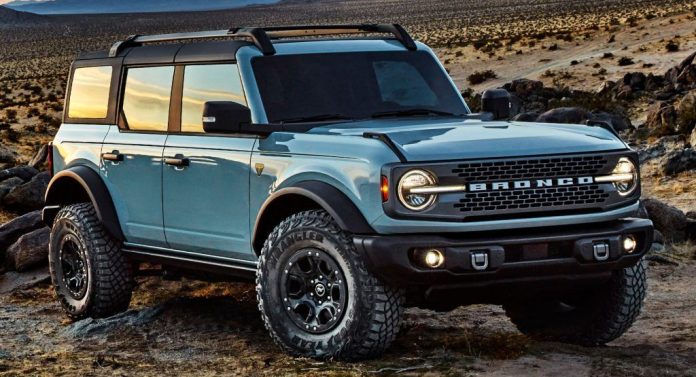

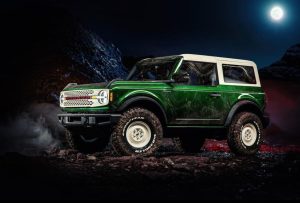

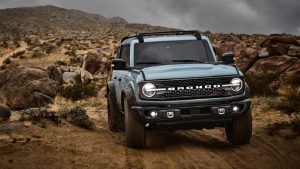

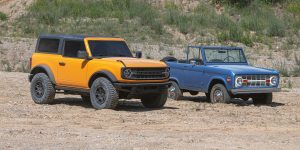








I’ll admit that the Bronco’s I’ve seen in town have turned my head, and that is coming from a 4Runner guy.
Is the new Bronco a 4Runner killer? Time will tell.
Sounds like Ford has a winner with a fun and useful vehicle.
How long until it has to go bye bye?
I am interested in getting a new Bronco. I am wondering about the life expectency of the 4 cylinder or even the 6 versus an 8. Seems to me they will not last as long. I had a 6.0 super duty and I had to replace the turbo on that twice in 160,000 miles, OUCH. Another concern with the manual trans, which I would prefer, is 6 or 7 gears, seems like a lot of shifting to me. I talked with my brother yesterday who has a wrangler with a 6 speed manual and he said, yeah it is a lot of shifting. My 3 speed CJ5 and my 4 speed f-150 with granny gear seem just fine without so many gears. Just trying to figure out my Bronco configuration.
Doesn’t really need more than 5 gears, 6th is solely for cruising on the highway.
As far as the turbo, upgrade it once it goes, the Aftermarket will have a viable alternative by then that will increase the power without stressing the internals too much, or you can go the big power/reinforce the block route
“7th” is really just a crawler gear, it’s under reverse, just solely for offroading when the trails require slow speeds, otherwise it’s just a regular 6spd.
2dr/4dr, either or works, although don’t think they’re opening the order banks until May. Bronco6g and the Bronco Nation forums are your best bet to figure it out.
Anything else, feel free to ask
Two doors? A real frame? Tires and suspension that work? Feeling a little light headed now!
Good on them for building a Bronco series not a one off cookie cutter rig.
Pops always said “only taxi cab companies and old people drive four door cars”.
I’m tall and don’t like my head next to the 4 door’s pillar but that’s where I end up with the seat far enough back for leg comfort. A new lineup with available two doors is intriguing.
Glad ya finally reviewed a Bronco Eric, proud owner here myself (2dr Rapid Red Manual Badlands), though gotta correct you on one thing
Manual is more paired with the engine, not the doors, unless you’re talking ’21 Sasquatches. Seen a few 4dr manuals, especially back when they were showing them off to people. Now they got Mansquatch’s coming out, manual sasquatchs, as it should have been, although it’s redundant if you got a badlands.
So much to do with them, taken my girl offroad, just had a soft top put on (Why Ford never gave me the option with my 2dr from the factory is beyond me), and taking her to Daytona next friday for Jeep Beach.
Offroading through the woods, never left first gear, and engaged the crawler gear for slower trails. I drive with a leadfoot, so she is thirsty, but it’s not like its any worse than my old truck (16 vs 13mpg for me, never use 6th gear really).
Only fill her up with Premium, and got a few mods (Fog light kit, spot lights on my bumper, kn filter, hood struts, A.S.S. Plug, soft top, bullet antenna, front plate delete, arm rest cover, center console parcel, vanity mirror lights, just a start), just now waiting for nicer weather before I flip the top back and drive without the rear windows or doors.
She always leaves me with a smile, no complaints other than just it’s not summer yet here in Jersey. Definitely recommend you drive one at least once!
Ford (F) common stock is sitting at 15 USD and change. It was at a low of 7 USD here a few years ago. EPS is 4.45 USD, so it is somewhat of a ‘buy’. A dividend of 40 cents helps.
I owned a 1984 Ford Crown Vic with a cold-blooded 351 that blew black smoke out the tailpipe every time you started the thing. Sold the pig for 500 dollars, never again will there be another Ford in the driveway.
Doesn’t mean the stock is a pig with lipstick on it, you can make some money. Looks that way, anyhow. If the Bronco can make a decent come back, so can a Crown Victoria SUV or something.
A Nissan X terra is a close competitor. They’re here in 2022.
Nissan is 8.19 USD today, it is a buy. Don’t own any, full disclosure.
Berkshire Hathaway (BRKa) is 485,500 USD per share today, where you have to gauge the market.
The Betrayal of Adam Smith
The new Broncos are nice , no doubt about that. But I have a Jeep Wrangler in the driveway, paid for. If I were a few years younger, I might entertain the option to purchase the new Bronco. But I will not give in to the high markups that are going on now at most if now all the dealerships and I do not want anymore monthly payments for the next several years. The bi-annual property taxes are bad enough!
Nice truck but, as noted, definitely Jeep Wrangler like. It’s interesting how different the original and old, old Broncos were from the 80s and 90s. Of course, Ford offered the small Bronco II later on. My brother had an ‘88 or so Bronco manual. Widest vehicle I ever rode in. I remember there being like 4 feet of floor space between the front seats. Real loose and squishy on the highway. A guy I knew got a new 92 for his first vehicle, promptly flipped it and drove it as a pickup thereafter.
I’ve seen quite a few of them out now and the design has a lot of visual heft. It looks purposeful and a nice homage to the original Bronco without being a caricature which is saying a lot.
Interesting that like the Wrangler, most of these won’t leave the suburbs. Also interesting that they have such a civilized ride. The 4-wheel drive trucks of yore were known for being bucking Broncos (pun intended) to passengers and the driver alike.
Hi Doc!
Much as I often grouse about new vehicles, there are times when I am amazed by them. As here. This thing rides far more smoothly off-road than my ’76 Trans-Am does, on-road. The suspension work is brilliant. Extreme capability with civility. I am impressed. Especially because I have driven original Broncos – from the ’60s and ’70s – and while they are extremely cool (and capable) vehicles, they are brutal to live with vehicles. Dangerous in the curves – if you don’t respect their limitations. Limited on the highway – at 70 you feel as though you are doing a very precarious 120. If you’re not very young and willing to put up with all that for the sake of the cool factor and the off-road capability, an old Bronco is not for you, as an everyday driver. This one absolutely is – without sacrificing anything in terms of capability.
‘This thing rides far more smoothly off-road than my ’76 Trans-Am does, on-road. The suspension work is brilliant. Extreme capability with civility.’ — eric
Fundamentally, an automotive suspension is a mass-spring-damper system, whose dynamic characteristics have been understood for a century.
Why did it take so long to evolve from the mushy (or jarring) messes of the 1960s and 1970s to today’s suspensions that evoke amazement even from seasoned automotive writers?
Wish I knew. Computer analysis helped. But mass-spring-damper systems could be analyzed on a time-sharing mainframe as far back as the 1960s.
At least the US fedgov’s regulators haven’t thwarted progress in this aspect of vehicles. Give them time, though … 13 to 14 inches of wheel articulation sounds mighty un-green. /sarc
I thought the same thing in my first ride in the Raptor pickup. OMG this things ride is amazing. It was hard to believe. I was very interested in buying one because of it, and was trying to find a way to get one, until I rode in a new gen Ram. It amazed me too, and was $25K +/- less than a Raptor, and why I ended up buying two rams eventually.
Great write up Eric.
I don’t know how the new Bronco is, but the old one was tough as NAILS! They routinely ran in the Baja races, where it’s an accomplishment to even finish.